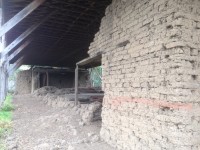This week I continue to share my experiences turning stones in Egypt. I left St. Catherine satisfied and looked forward to relaxing while we made the three hour journey through the Sinai to coastal town of Dahab. Andrew and I came prepared with a snorkel and mask carried with us from the homeland. Good thing too, because Dahab offers one of the premier snorkeling areas in the world.
There is truly something magical about floating on one’s stomach and simply absorbing the colors and sea life. In the old days, about 30 years ago, Dahab was a Bedouin fishing village. With tourists flocking to Sharm el-Sheikh on the Red Sea, Dahab, a mere hour’s drive to north on the Sea of Aqaba, one easily visualizes Lawrence of Arabia perched high on a camel making his way slowly along the shoreline.
We wound our way down a dirt road to the north end of town, an area known as Asalah. Here, divers come from every corner of the world to dive the coral reefs around the Blue Hole. Coral surrounds a submarine sinkhole about 500 feet deep. At about 184 feet deep, one finds a 60 foot long tunnel stretching to the open sea. Locals claim the Blue Hole is cursed. A Bedouin legend states that it is haunted by a girl who drowned herself to avoid an arranged marriage.
Divers flock to Dahab to swim down to the tunnel, then through it, hopefully resurfacing on the other side, all while holding one’s breath. A stone wall back on shore is covered with memorials, honoring those who didn’t make it. Andrew and I swam the outside of the coral reef, enjoying hundreds if not thousands of colorful fish. When we gazed to our left, it appeared as a bottomless pit.
Across the Sea of Aqaba from Dahab, the low mountains of Saudi Arabia seem close enough to touch. In fact, one of our excursions took us to the uninhabited island of Tiran, claimed by the Saudis. In 1967, the Arab-Israeli War, known to Egyptians as the Six-Day War, included a short skirmish between Israel and the United Arab Republic (Egypt, Jordan and Syria). During the war, Dahab was occupied by Israel, who named the town Di-Zahav. The name refers to a location mentioned in the Bible as one of the stations for the Israelites during their Exodus from Egypt.
Our exodus from Egypt was eminent. We enjoyed our last evening chowing down on lamb seasoned with fresh cardamom, babaganoush and freshly baked bread fresh from the outdoor oven. The sunset was exquisite, illuminating the western peaks of the peninsula. The next day we would follow the sunset, leaving sunny skies for cloudy, excited to explore the ancient cobble-stoned streets of Paris.
We only had a day and half in France and I wanted the experience to be more cultural for Andrew and I, so we walked. We arrived hungry and our first stop was at one of the zillions of local bistros. For Andrew’s edification, I immediately ordered six slimy snails followed by a luscious veal stew.
Our feet took us to the Eiffel Tower, Arc de Triomphe, down the Avenue des Champs-Élysées and over to the Louvre. The Louvre, now one of the world’s largest museums, was originally built as a fortress in the late 12th century. Because I was with a child, we came to the Louvre for one thing and one thing only. We came to see Mona’s smile.
We followed the Seine back to our hotel. We sat on park benches. We took it all in and tried to speak French. We ate at crowded Bistros, drank expresso and hot chocolate, devoured pastries and bought key chains with the Eiffel Tower. We turned many stones, but realized the best stones were sitting silently right in our backyard. We were more than delighted to jump on the plane that would take us on our journey home.


“United Arab Republic”
jordan? you seem a tad confused as to the history. cheers, mate. no worries.